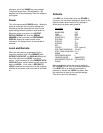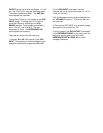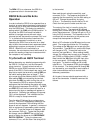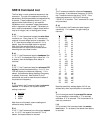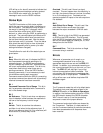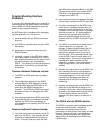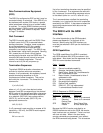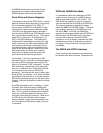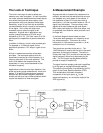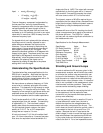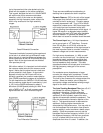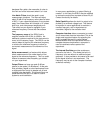20
LED will be on for about 2 seconds to indicate that
the stored instrument settings are being ignored.
If the RS232 echo mode is on, the sign-on
message is sent over the RS232 interface.
Status Byte
The SR510 maintains an 8-bit status register
which the user may read to obtain information on
the unit's status. The status byte may be read in
two ways: by sending the Y command, which
returns the value of the byte in ASCII coded
decimal, or, when using the GPIB, by performing a
serial poll. The returned status byte reflects all of
the status conditions which have occurred since
the last time the byte was read. After the status
byte has been read, it is cleared. Thus, the status
byte should be read initially to clear all previous
conditions (especially after a power up or after
settings have been changed).
The definitions for each bit of the status byte are
given below:
Bit 0
Busy. When this bit is set, it indicates the SR510
has unprocessed commands pending on its
command queue. For RS232 communications,
this bit is always high since the Y command itself
will be an unprocessed command. This bit is not
reset when read but only when there are no
pending commands. Since the SR510 buffers
incoming commands, it is not necessary to read
this bit before sending each command.
Commands received while the SR510 is executing
a previous command are stored until all previously
received commands have been executed.
Bit 1
Command Parameter Out of Range. This bit is
set if a parameter associated with a command is
not in the allowed range.
Bit 2
No Reference. This bit is set when no reference
input is detected, either because the amplitude is
too low or the frequency is out of range.
Bit 3
Unlock. This bit is set when the reference
oscillator is not locked to the reference input. If
there is no reference input, bit 2 (no reference) will
be set but bit 3 (unlock) may not be.
Bit 4
Overload. This bit is set if there is a signal
overload. This can happen when the sensitivity is
too high, the dynamic reserve is too low, the offset
is on, or the expand is on. Overloads on the
general purpose A/D inputs or the ratio output are
not detected.
Bit 5
Auto Offset Out of Range. This bit is set if the
auto offset function cannot zero the output
because the output exceeded 1.024X full scale.
Bit 6
SRQ. This bit is high if the SR510 has generated
an SRQ on the GPIB interface. This bit is reset
after the SR510 has been serial polled. This bit is
set only for status reads via a serial poll, ie., Bit 6
always zero for the RS232.
Bit 7
Command Error. This bit is set when an illegal
command string is received.
Errors
Whenever a 'parameter out of range' or an
'unrecognized command' error occurs, the
appropriate status bits are set and the ERR LED
flashes. In addition, any commands remaining on
the current command line (up to the next <cr>) are
lost. The ERR LED will also light if any of the
internal communication buffers overflows. This
occurs when 240 characters are pending on the
command queue or output queue. The ERR LED
will go off as soon as all buffers drop below 200
characters again.
Reset
The Z command resets the unit to its default state.
The default front panel settings are listed in the
DEFAULTS section of the Guide to Operations.
In addition, the interface status returns to LOCAL,
the SRQ mask is cleared, the RS232 character
WAIT interval is set to 6, and the terminating
sequence is reset to the proper defaults.
The command and output buffers are cleared by
the Z command. Therefore, it is bad practice to
use the Z command before all previous commands
have been processed and all responses have
been received.



